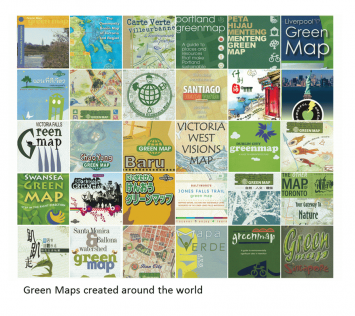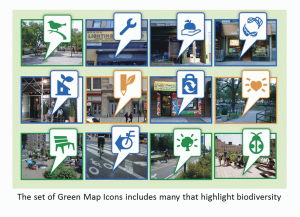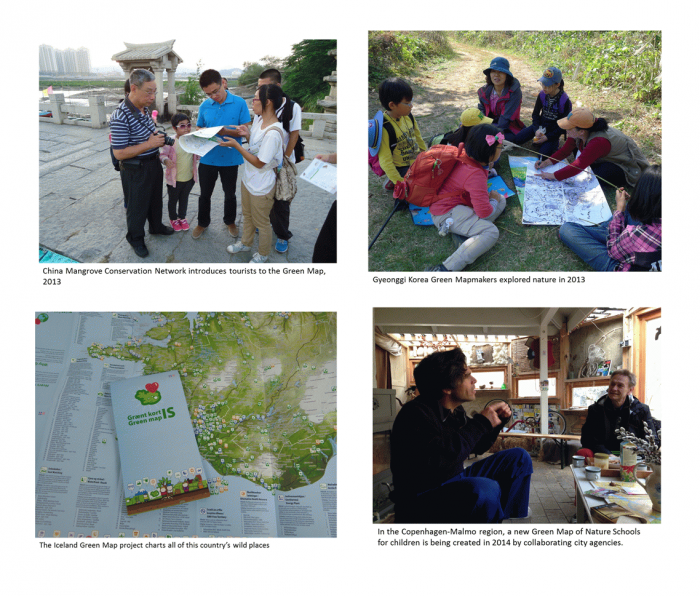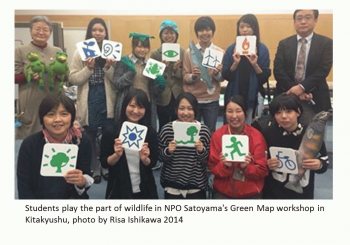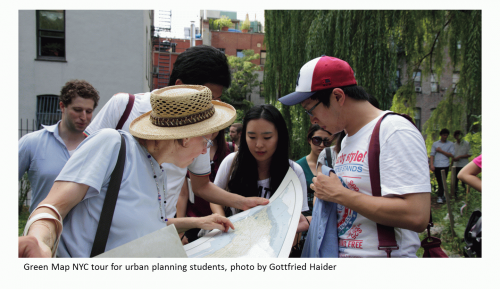The Web of Life - A Story about the Green Map
- Wendy E. Brawer
- Founder and Director, Green Map
Green Map System’s story starts in 1989. I was back in Asia, this time exploring Indonesia. One night in Yogyakarta’s Arab Night Market, a captive orangutan and I locked eyes. Her long arms stretched outside the confines of a tragically tiny cage, and restlessly, she flipped a stone up and down in her hand. I was transfixed by the sorrow in her face and wordlessly, I tried to communicate my concern. The Orangutan's smooth, round stone flew toward me. Catching it marked a turning point in my life.
At that moment, there was no hint of how this cross-species intervention would help start a movement now impacting the environment and biodiversity in hundreds of communities around the world. Yet as I returned home to New York, I began working toward designing products and services that would spur understanding of our complex world, rather than continue to products that would generate waste and extinction. The Orangutan's stone had activated me, and in turn, I sought ways to share this energy. An answer that was both practical and inspiring began to gel as I considered the rapidly-changing world around me.
My ‘lightbulb moment’ occurred during a planning meeting for 1992’s Earth Summit. Although the main event would be held in Rio, leaders, delegates and NGOs would work in New York at the United Nations developing the principles underlying Agenda 21. I wondered if they would be able to perceive signs of progress toward sustainability as they explored my city? How could I help them connect with the community gardens, farmers markets, ocean beaches, ecology centers and programs that increase the vitality of local biodiversity?
I was inspired to design something that would illuminate all of these places in a universally understandable and resource efficient way. I decided to make a unique map that would contextualize our city’s richness from a green perspective, offering a friendly introduction to local sustainable community development and an enjoyable experience. Within a day, this map had a name, donated printing, a network of expert contributors and boom! The first Green Map was an instant success.
Very soon, people in other cities wanted to create one, too, and this inspired the development of adaptable tools and a shared symbol set. Catalyzed by love and urgency, our locally-led, globally linked movement was underway.
Growing in reach and diversity, year by year, today the non-profit Green Map System is approaching the 900 project milestone. Led by city officials, social entrepreneurs, NPOs, universities and youth, together, we are impacting cities, towns and campuses in 65 countries. Although each Green Mapmaking team has its own vision and process, every map is linked by the Green Map Icons that identify Nature, Sustainable Living and Culture & Society sites. Globally recognized and evolving with our understanding of sustainability, these 170 icons include both positive and negative sites so mapmakers can illuminate the challenges communities face, as well as the assets.
Some of my favorite icons were designed in a workshop at Honen-in, a beautiful Buddhist Temple in Kyoto. The concept for the Special Tree icon came right from Honen-in’s courtyard, where a sacred Camellia had bloomed in three colors. The wind stirring the ‘dancing leaves’ became our composting symbol, and the little bird sketched there still signifies Wildlife Watching Site, adding liveliness to every Green Map as it does to our world. Coastal, amphibian, marine and insect habitat symbols are used on many Green Maps to share an integrated view of the environment. Local food is the ‘gateway’ to sustainable thinking for many people and our Farmers Market icon provides a connection to regional bio- and cultural diversity. Used as an inventory tool, these and many other icons instill the maps with a fresh perspective on the uniqueness of the nature of home.
The outcomes have been remarkable and moving, as seen throughout our website and at GreenMap.org/impacts where you can download the book that we co-published with Green Map Japan and Green Map Aichi, important partners to Green Map System. Although the network of projects within Japan was stronger prior to the Tohoku Disaster, this partnership has benefited our entire movement. Here is a mapmaking highlight:
In 2010, the United Nations Convention on Biodiversity, COP 10, was held in the Aichi region of Japan. There, 40 great new Green Maps focusing on biodiversity in rural and urban areas were exhibited, thanks to the efforts of the 8 year-long Green Map Aichi project led by Keiko Nakagawa of the NPO, Chubu Recycle. Honoring COP 10 and reflecting on the lasting impacts of EXPO 2005 on this central Japan region, these lively Green Maps shared a richness and wonderment achieved through careful stewardship and observation – download the book of maps at goo.gl/wG2akE.
Green Map Aichi also developed a season-long public awareness project leading up to COP 10 with a local media channel featuring a newly mapped site each day, such as an urban farm that could be rented by families, a traditional kimono shop using natural dyes such as cherry tree bark, and the Odaka Midori District marshlands where beloved dragonflies hover and dart.
Misako Yomosa, Director of Green Map Japan participated in the Cop 10 exchange along with a wide diversity of participants, including Miki Oya of the Rokojugata Tidelands Green Map project, which has forestalled biodiversity-impacting development in Ise & Mikawa Bay (and discovered a new species!), Marco Kusumawijaya from Jakarta Indonesia, representing Green Map Asia and myself, representing the global Green Map network. Along the way, I met with the outstanding Kitakyushu Green Map program, led by the NGO Satoyama, where mapping biodiversity in partnership with the Kitakyushu Environmental Museum plays a central role on an ongoing basis.
Moving to the Middle East, you’ll find Biodiversity Village Green Map projects in Lebanon, which are supported by the IBSAR program at the American University in Beirut. Over the last five years, dozens of villager groups have met with research teams. They start by re-defining the Green Map Icons in the local context, and as they create their Green Map, they select the three most important plant species for their village. Together, they plant more of these species, which are often fruit or nut trees. Today, 30 interactive Open Green Maps of these villages can be explored on our platform (see goo.gl/5gxMTo), and soon, this data will be part of a locally-produced mobile app that notifies users as they get close to one of these widely-scattered biodiversity village green sites.
Travel south to Cape Town, South Africa, where responsible tourism is central to the mapmaking project, seen online at CapeTownGreenMap.co.za. Both this website and the city’s interactive and printed Green Maps motivate tourists and residents to explore this biodiversity-rich tip of the continent. The Green Map project supported the successful campaign to have the city’s ‘centerpiece’, Table Mountain, officially included in the very short list of New7Wonders of Nature, among other efforts to support flourishing wildlife.
Swing over to Baltimore, a mid-sized US East Coast city alongside the rich estuary of the Chesapeake Bay, where a Kickstarter campaign was launched by the Baltimore Green Map organization in 2012. The goal was two-fold: raise awareness of the remarkable Druid Park, a vital natural resource in the center of the city, and to develop the resources to fund a Passport to the park. Successfully designed in collaboration with the well-established Friends of Druid Park network, this booklet comes with a Green Map, stickers and tips for understanding the park’s natural heritage, history and volunteering opportunities, as seen at BaltoGreenMap.org
The story comes full circle, back to Yogyakarta. There, the place where I met the Orangutan has been put on the Green Map created by local people, and she is credited with starting the movement. Even in my own most urban home, I’m delighted that she has also inspired me to include information about the diverse species who swim through, fly by and reside in New York City, and highlight our beaches, parks, gardens, urban farms and resiliency resources. In many ways, I feel I am fulfilling a mission I was handed at birth when my parents gave me the initials WEB, impacting my perception and practices throughout life:
I see the world as an interconnected whole, a delicate web of incredible strength. My empathy for other species has helped me to think and work creatively, and opened the door to interacting with so many great people and environments, utilizing the info-web in service of the web of life.
Portrait Photo by Peter Shapiro 2013
Profile of Wendy E. Brawer
Focused on sustainable design for more than 20 years, Wendy E. Brawer’s original Green Map of New York’s green living resources sparked a capacity-building movement that has impacted more than 65 countries since 1995. A pioneer in internet-based collaboration, she has led the development of participatory tools, icons, mapping platform, multimedia and events, as seen at GreenMap.org. Wendy has also produced numerous interactive and print maps for New York City, as seen at GreenMapNYC.org.
A native of Detroit, USA, Wendy was an artist when she moved to Tokyo in 1985. There she began shifting toward product design. By 1990, she was working as an eco designer and co-teaching NYC’s first university-level course on Design for the Environment at the Cooper Union. She has been appointed Designer in Residence at Smithsonian Cooper-Hewitt National Design Museum, a Woman of Earth (Terre de Femmes) and an Utne Visionary, as seen at EcoCultural.info. An active member of boards and community projects in Manhattan, Wendy's areas of expertise and social innovation include design for resiliency, co-development and community engagement.







